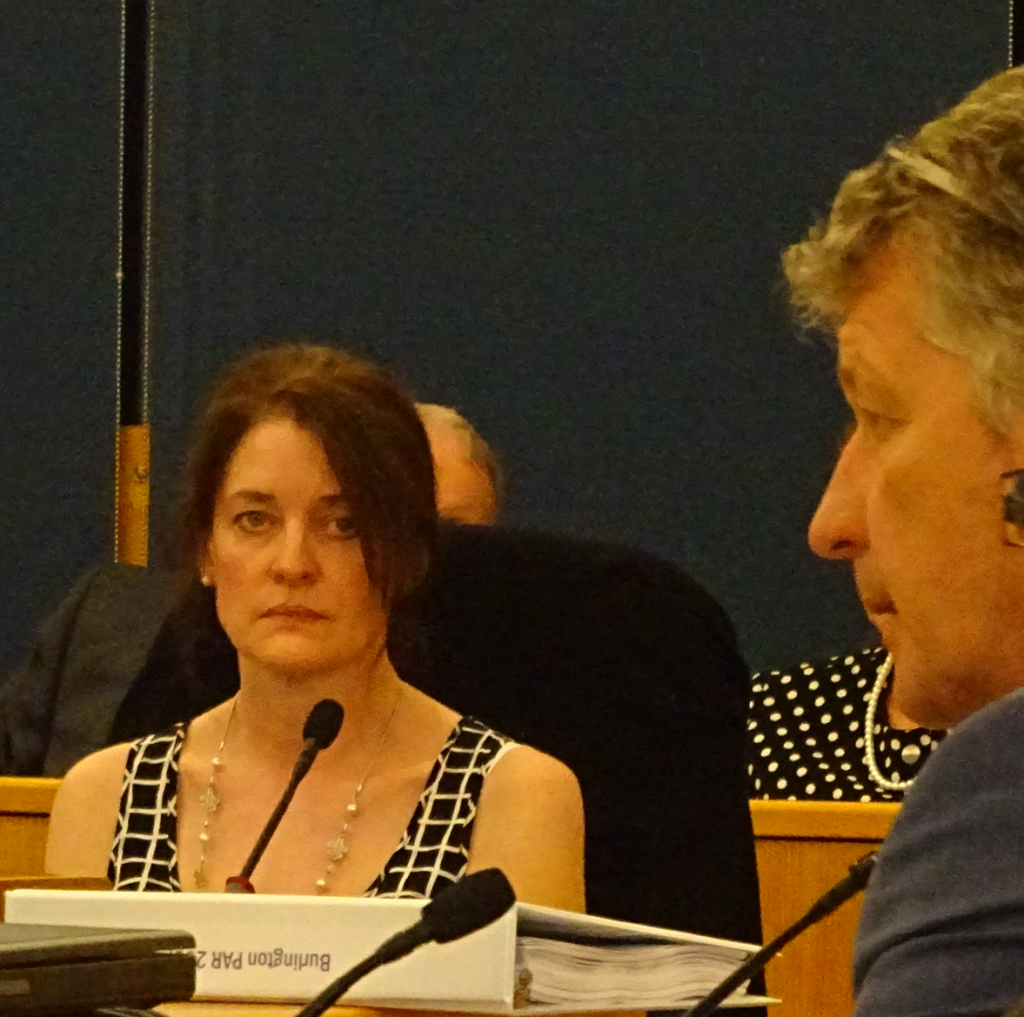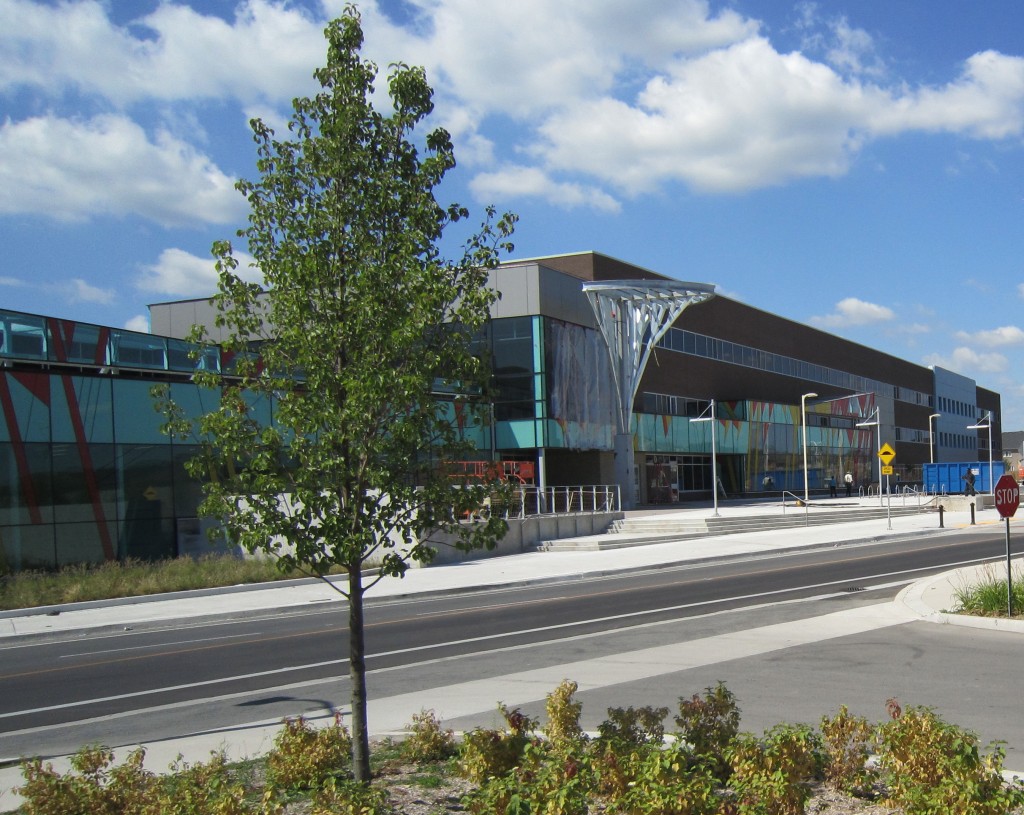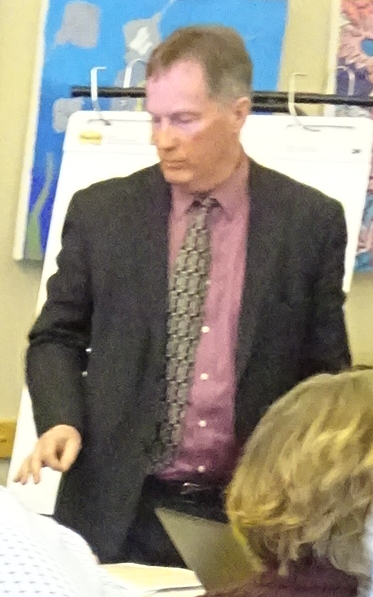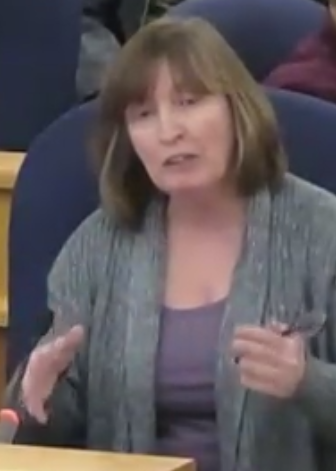June 5th, 2017
BURLINGTON, ON
Right from the very beginning Ward 5 Halton District School Board trustee Amy Collard was paying very close attention to what was being said about high school closures in Burlington. While the Robert Bateman high school was not recommended for closure by the Director of Education in his initial report, Collard was acutely aware that its distance from Nelson high school – less than 2km to the west – made it a closure possibility.

Bateman principal Mark Duley could not have know he was going to have to sound an alarm and tell parents that there school was at risk. Dudley was using a fire alarm during a student cook off against Burlington fire fighters
The Bateman parents didn’t have their ears to the ground but Principal Mark Duley knew his school was vulnerable.
Because they didn’t feel at risk – the Bateman parents did next to nothing as the Program Accommodation Review Committee wound its way through the seven meetings they held. There were exceptions: Sharon Picken and Lisa Bull, the Bateman members of the PARC, worked very hard to get the Bateman story out. They didn’t realize Bateman was going to end up on the PARC list of schools that could be considered for closure until the third PARC meeting when Bateman was added to the numerous options that were before the PARC.
When the Director of Education revised his initial recommendation and took Central high school off the list and added Bateman, a community that was not ready for the fight of their lives had to pull together. Unfortunately, the Bateman community turned on the Central high school people and accused them of “throwing Bateman under the bus” when what they needed to do was get their story out.

The PARC met on seven occasions and turned out to be a lot more deliberative than Board staff expected. Two parents from each high school served the community very well.
With the PAR committee disbanded the trustees got to hear the delegations – there were 51 of them delivered over two long evening sessions. The Bateman story was very effectively told – what no one could tell for certain was – were the trustees listening; more importantly were they hearing?

A single parent, deaf, mother of two using sign language to communicate. Her daughter, a severally disabled child takes part in the Community Pathways Program at Bateman high school.
Each delegation had five minutes to tell their story and an additional five minutes for the trustees to ask questions – there just weren’t that many really good questions from the trustees.
The public learned Bateman had an auto body paint shop that was close to world class – the equipment had been donated by Toyota; students from that program had gone on to win competitions on the other side of the world.
There was a welding program that was getting excellent reviews and a culinary program that was very popular. The biggest plus was the Community Pathways Program (CPP) that educated, nurtured and cared for exceptionally vulnerable students.
During the delegations there was a single parent who was deaf and used sign language to communicate with her daughter who was unable to control her bodily functions – but her mind seemed to be sharp. Watching the delegation was a heart wrenching experience. There were other parents with children in the Community Pathways Programs (CPP) who delegated very effectively,
Other than the parents of these children and other students at the high school few knew they were there. It was a truly amazing delegation to watch.
Denise Davy, a skilled advocate brought her experience to the fight – and it was a fight. She got decent CHCH television coverage and delegated very effectively at city hall as well.
But nothing changed.
The response from the Board staff was that these were all programs that could be replicated at Nelson high school where much of the Bateman program was headed if Bateman was closed in 2019
The auto body paint shop – the one at Nelson would be even better; welding – same thing – the Board staff told anyone who asked that the move would give the Board a chance to upgrade everything. They were a little weak on the details.
The transformation from Bateman to Nelson – not a problem – every time the Board staff did a transformation they got better at it, they said.
It was a trust issue and the public, at least for those who were involved in the school closing issue, just did not believe senior staff or the Director of Education.
Board staff seemed blissfully unaware of the depth of that distrust. There were parents who went over the top emotionally – they were the exceptions.
There were also some solid, fact filled delegations that pointed up serious flaws in the way the Board staff had created catchment area boundaries and the selection of the feeder schools.
The Board Planning department seemed prepared to give out whatever information they felt would serve their immediate purpose – then later give significantly different information to an almost identical question.
It struck many as a level of manipulation designed to give the Board staff what they wanted rather than what was best for the community. The Board staff philosophy seemed to be larger high schools offered better program opportunities for students. Much of the evidence from the Board’s research didn’t support that contention.

Ward 4 trustee Amy Collard held Director of Education Stuart Miller\s feet to the flames and didn’t give an inch with her persistent questioning during the Board information session.
When the Director’s second recommendation came out with Bateman on the list of schools to be closed, the activists at Bateman accused the Central parents of throwing them under the bus and things got very nasty.
The issue was now before the trustees and Amy Collard was now able to do what she had been wanting to do – get some ideas on the table and find the solutions that would prevent the closing of a school.
There was a public hungry for information but there wasn’t much the trustees could do up to this point.
They had created a Program Accommodation Review Committee (PARC) then they had to stand back and let that committee do its work.
Collard, along with all the other trustees, had to sit on their hands, while two parents from each of the seven high schools discussed the options that were before them and began narrowing a long list down to a short manageable list.
The PARC did a lot more than Board staff expected – while they didn’t disband with a consensus they did narrow down the options – from the 30 they were given, to which they added a dozen or so – got narrowed down to five.
The surprise for the people at Bateman was that they were now on the list of schools that were being considered for closure.
When the PARC came to an end it was time for the public to delegate. There were 51 of those heard over two public meetings.
For the first time the public got a sense of what Bateman was really all about. The depth and significance of their programs had not been discussed openly. The parents with children in the school knew the story – the public hadn’t heard it in so much detail.
Bateman had a superb story that wasn’t told until public delegations were heard; by that time they were fighting an uphill battle.

Rory Nisan on the left exchanging contact information with George Ward, a parent who was active when Lester B. Pearson was created as a community school – an experiment that worked but which the current school board administrative leadership does not appear to want to continue,
Lester B. Pearson had a story as well– about how they had been stiffed by their Board with hardly a word from the trustees and less than a peep from the ward trustee.
Pearson had had the bulk of its feeder school taken away from them and given to Hayden high school where the overcapacity was approaching the 140% level.
The delegations ranged from some rather silly ideas to emotive pleas from parents to not close “their” school. There were also a number of very good delegations – excellent as a matter of fact.
Each of the trustees reacted differently to the delegations – some had strong relationships with the schools they were responsible for and they worked their connections. Others clearly didn’t understand what their job was and others failed to reach their potential as trustees.
The public isn’t at all aware of how hard these women work. While they grapple with a very significant closing schools decision, they are working their way through the budget – the school board is the biggest employer in the Region.
They meet weekly, which we don’t see at the municipal level. They are for the most part diligent and struggling to fully understand the longer term impact of what they decide to do on the June 7th.

Hayden High, Burlington’s newest high school built as part of a complex that includes a Recreational Centre and a public library with a skate park right across the street.
It was a decision to create the Hayden high school in Alton made in 2008 that started a series of events that put the Board of Education in the position it is in now.
To add to the really messy situation is the way the Board of Education communicates with its public. Director of Education Stuart Miller has been very direct and said on more than one occasion that the Board doesn’t do a very good job at communicating with the public.
Add to that some parents whose emotions got the better of them and made statements that were just not true.
It has been a very difficult story to cover
Collard who has more Board experience than the other three Burlington trustees, has been very proactive in looking for solutions. She hasn’t always gotten the attention many of her ideas deserve but that hasn’t deterred her in the least,
Following the delegations was an “information” meeting of the Board during which Staff set out to defend the recommendation that the Director had presented the trustees.
Collard was the first person to put a question to Director Miller when the information session started – which he basically said he wasn’t going to answer.
Miller was surprised and caught off guard – he was expecting to be able to explain his decision and position now that the PARC had done its job and the trustees had heard all the delegations.
Miller was there to defend his recommendation which Collard wasn’t buying. Each trustee had many opportunities to ask questions of the Director’ recommendation and to pepper him with questions based on the material that came out of the PARC and the 51 delegations.
How did they do? They asked a lot of questions and Miller along with his Planning manager Dom Renzalla and PARC Chair Scott Podrebrac handled them reasonably well.
The “information” session went much longer than many expected – they were still at it when the Chair chose to recess the meeting for a week – and come back at it again.
During each of these session Collard kept hammering away at what could and should be done with Bateman.
The senior Board staff kept giving the trustees smooth assurances that the transition from what is in place now to what they will end up will go just fine.
A number of the trustees weren’t buying that line.

Gerry Cullen, Superintendent of Facilities, explaining why much of the data he provided kept changing.
Gerry Cullen, Superintendent of Facilities was already measuring Nelson for the influx it was going to experience with the number of programs that would be transferred from Bateman to Nelson in 2019.
Collard’s objective is to keep the Robert Bateman high school open – and she has put two possibilities on the table.
1) Develop a partnership between Bateman and Nelson
Students from both schools could attend classes at either school. This would increase the breadth of program offered to all students.
Students in Essential, Community Pathways and
International Baccalaureate programs would continue at Bateman without disruption.
The commercial grade kitchen facilities at Bateman would continue to be viable.
Centennial Swimming Pool would be accessible to all students at both schools.
The auditorium and stadium at Nelson would be accessible to all students at both schools.
The OYAP and SHSM programs offered at each school would be available to students at both schools.
Collard said the operationalization of this idea would need to be determined. Her preliminary thoughts as to how it might be accomplished included:
Each school continuing to offer the full suite of required courses – as well as the specialized programs that are already in place – to the students in their current catchment area. Students wishing to participate in courses offered at the alternate campus could decide to take their entire course load or half of their course load (morning or afternoon) for that semester at that campus. Regional programs would continue to be offered at their current locations.

Centennial Pool, which is attached to Bateman high school will become a bit of an orphan if the high school is closed.
Each school might offer specific courses – for example Students in Grade 9 regular English program could have Physical and Health Education and French at Bateman in the morning periods and Math and English at Nelson in the afternoon periods. This would give all Grade 9 English program students at both schools access to Centennial pool for their Physical and Health Education program.
Shuttle bus – it is about a 20-30 minute walk between Bateman and Nelson, so they may want to provide a shuttle service between the two schools.
Collard argues that this approach increases equity of access to program for all students at Bateman and Nelson and it increases equity of access to facilities, including the Commercial Grade Kitchen, Automotive and Welding Shops, Auditorium, Greenhouse for all students at Bateman and Nelson. It also does away with the emotionally difficult transitions for students in Essential or Community Pathways Programs
This approach also eliminates the need to move the International Baccalaureate Program from Bateman to Central high school – problem with that is Central needed those IBL students to get its enrollment numbers up – and – the IBL has a certain cachet to it that Central would like to acquire.
Collard pointed out the her suggestion reduce renovation costs at Nelson which were set at $12 million. The suggestion preserves the ability to maintain the YMCA Daycare at Bateman and ensures the viability of Centennial Pool and increases access to extracurriculars for all students.
Collard does concede that the suggestions does require some creative logistical efforts – especially in the first year of implementation
Transportation might be required to ensure students can attend classes at both campuses – these costs might be mitigated since students living in the eastern area of the Bateman catchment (who would be redirected to Nelson if Bateman were to close) would not require transportation to Nelson.
Creating community partnerships:
Collard also saw some significant opportunities for real Community Partnerships. The unique specializations offered at Bateman have considerable community appeal. The Commercial Grade Kitchen at Bateman could be used in a partnership with the Halton Multicultural Council (HMC) to help newcomers to Canada learn hospitality skills that can lead to gainful employment. Collard had a conversation with the Executive Director at HMC who happen to be seeking a space in which to provide this type of program.
Bateman offers skilled trades that aren’t currently available at The Centre for Skills and Development; specifically automotive and culinary. A partnership with The Centre could be beneficial to the community.
Collard has done what parents have a right to expect from their Board of Education trustees. She has been both proactive and innovative. One cannot say as much for the ward 4 trustee. The high school in that ward, Lester B. Pearson, has gotten more support from the city Councillor who has zero clout on the high school closing issue.
Collard is not a popular trustee. She doesn’t expect to win a popularity contest; she wants to do the job she was elected to do. She was acclaimed as the ward trustee during the past two municipal elections. She served one session as vice chair of the Board and has sought the votes of her peers to serve as Chair – that has not been forthcoming.
Collard is abrupt, she is direct. She tends not to get into much of the chit chat with the other trustees.
But – and this is important – she is the only trustee who has put a solution, an alternative, on the table. Her fellow trustees may not follow her lead – but they can and should give her ideas full debate and consideration. If they cannot accept her approach they might want to look at option 7 – don’t close any of the schools – until there has been a more fulsome and through debate.
Denise Davy made a very significant point when she noted that the city of Burlington spent more time and debate on deciding where to put the Freeman Station than the school board has spent on closing two high schools
























I too applaud the effort Trustee Collard has put into not only saving Bateman but at looking for options and partnerships to keep schools open. You have held Miller accountable through your questions, as it should be. The trustees were elected by the citizens and should remember that fact. They represent not only the citizens and students. Do not just accept the proposal. Challenge it.
Miller said at the one meeting (as rationale) for closing Bateman vs. Nelson that he couldn’t justify closing a school with 700 plus student population. According to a newspaper article, I just read, Bateman was stated to have 800 students. That shoots that justification to pieces. The 90% capacity (or bums in the seats)) that the board is after is their number and not a Ministry of Education number. By 2020 all schools will be at a 85-88% capacity. Does this justify closure of 2 schools?
Craig – thank you for also pointing out the work Bateman did to repair the damage done at the Burlington Festival of Lights. I was not aware of this but is just another example of this schools unique character.
As a parent with students at both Robert Bateman and LBP I again ask how this has been in the best interest of the students? The uncertainty, the angst, the change in personalities, the transitions (especially for those who need either the services that Bateman offers or the smaller school setting (for non-physical challenges) that others need seems to have made little impact on the administrative staff. In fact Mr. Miller indicated he hadn’t even “considered” keeping a smaller sized school open. Why? How then did he ever consider these students needs? They are invisible it seems.
To those trustees who have fought not only for their schools, but all schools – thank you. For those who took the time to respond to inquiries and emailed comments – thank you. For those who took the job with a view to keeping schools open and doing everything in their power to provide opportunities for all students – thank you. For those who forgot what they were hired for or how to effectively carry out that role, perhaps one should reflect that you are not in the right career field. It isn’t about rubber stamping proposals. It is about the students – right?
Did anyone bring up the relationship Bateman has with the Burlington Festival of Lights. Two years ago Bateman students repaired the vandilized toy soldiers at the entrance to Spencer Smith Park and this past year the Bateman kids designed and built the new Hockey display that was added. In addition a number of the students come out as volunteers to set up the 50 + displays in the park. I believe they are currently working on design/build of a soccer display for 2017 or 2018.
I would say Trustee Collard has fulfilled her job well, the one she was hired to do. Not knowing the value Bateman brought to the community until now, it’s clear to me there’s more than enough reason to keep this gem open.
I wish the community surrounding Pearson was so lucky. I realize the point was already made but it’s worth stating again. Trustee Papin is out to lunch. Retribution would be great in the form of her losing her job come next election but it doesn’t make me feel any better. Her lack of effort may very well be a leading factor in the loss of Pearson.
Trustee Grebenc has equal stake in the decision of whether to close Pearson. MMR would benefit from the numbers, this is without doubt. But closing Pearson doesn’t help Hayden. In fact, the high school in Grebenc’s wards will be negatively affected by the elimination of seats in the north. Close Pearson and in the very near future there will be two schools overcrowded north of the QEW. The stats have been presented to Andrea more than once…but no interest. Hopefully I’m just missing the work behind the scenes where she’s educating other trustees on the need to keep Pearson open. It’s all I can hope at this point from this fellow LBP Alumnus who is entrusted to make an important decision.